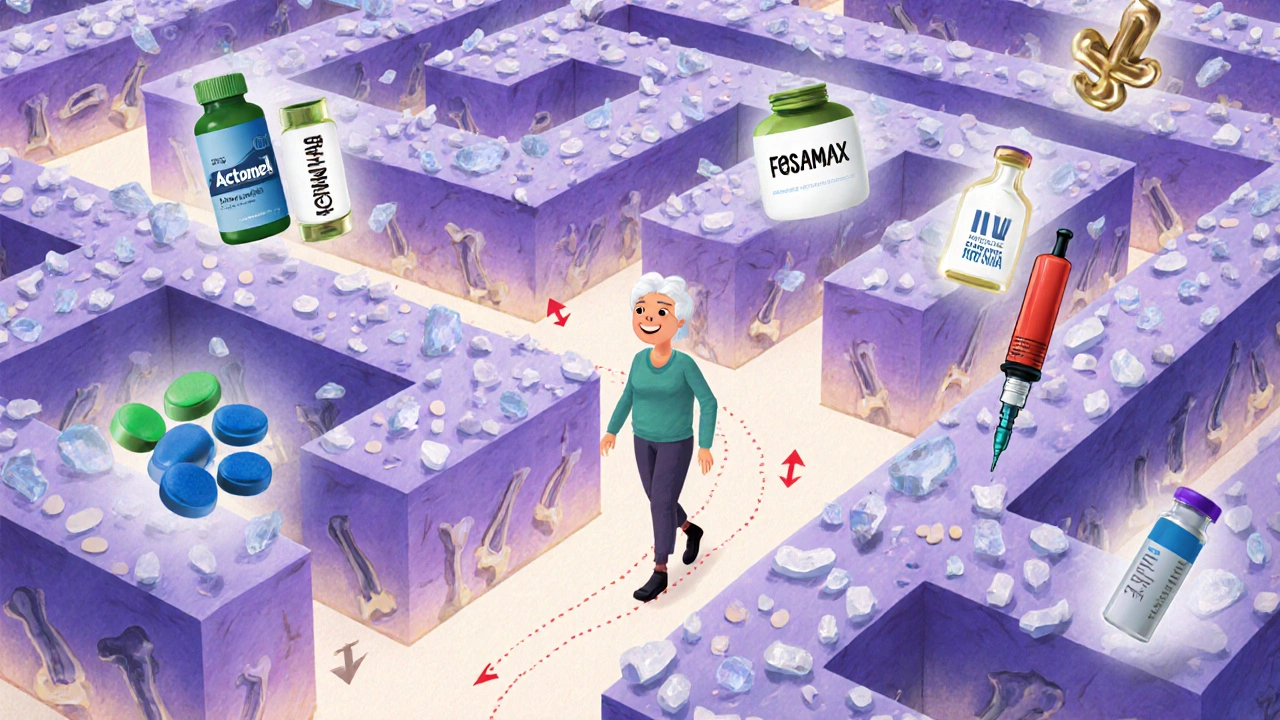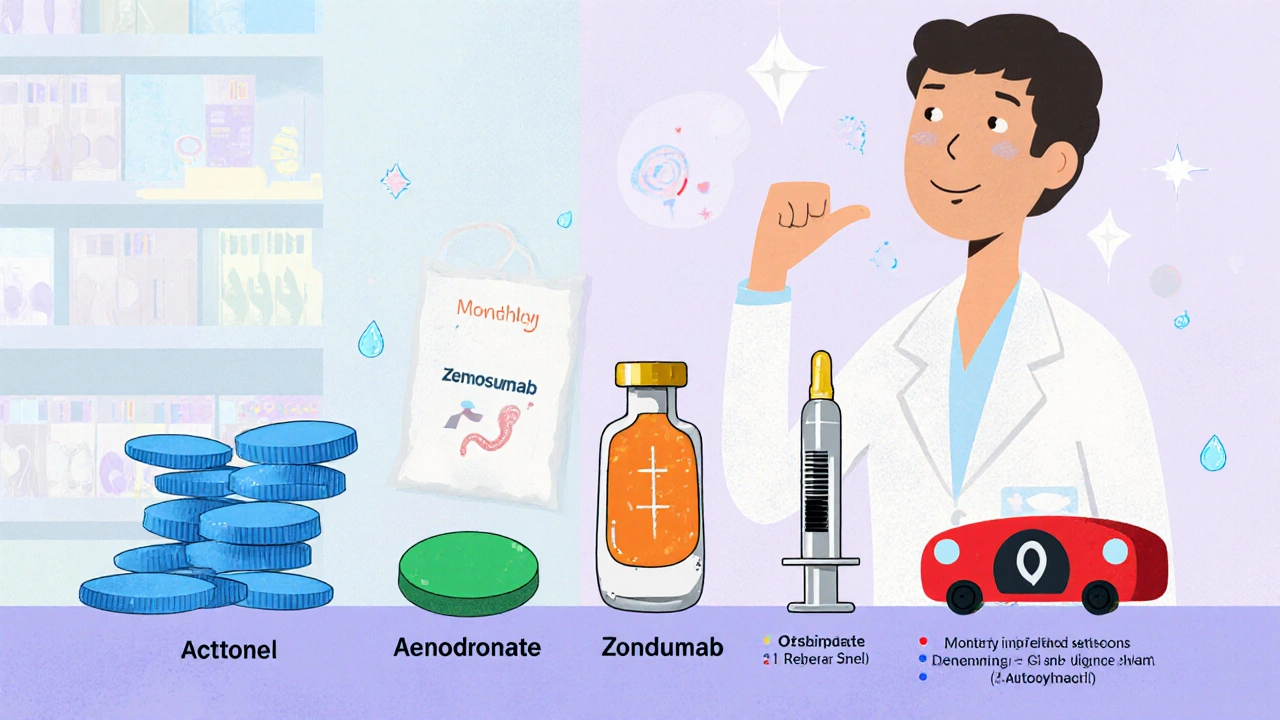Actonel (Risedronate) vs Alternatives: Pros, Cons & Best Choices

When it comes to protecting bone health, choosing the right medication can feel like navigating a maze. Actonel (risedronate) is a popular option, but several other drugs promise similar or even better results. This guide breaks down how Actonel stacks up against its main competitors, helping you weigh efficacy, safety, dosing convenience, and cost so you can decide what fits your lifestyle.
What is Actonel (Risedronate)?
Actonel is a brand name for risedronate sodium, a bisphosphonate that slows bone loss and reduces fracture risk in osteoporosis patients. It works by binding to bone mineral surfaces and inhibiting osteoclast-mediated bone resorption. The drug is typically taken once a week as a 35 mg tablet, with strict instructions to stay upright for at least 30 minutes after swallowing.
How Do Bisphosphonates Work?
Bisphosphonates, the class to which risedronate belongs, target the cells that break down bone. By attaching to hydroxyapatite crystals, they become internalized by osteoclasts during bone remodeling. Inside the cell, they disrupt the mevalonate pathway, leading to reduced osteoclast activity and eventual apoptosis. The net effect is a slower turnover rate, which lets the body rebuild stronger bone over time.
Key Factors to Compare
- Efficacy: How well the drug reduces vertebral and non‑vertebral fractures.
- Dosage & Administration: Frequency, route, and any special instructions.
- Side‑Effect Profile: Common and serious adverse events.
- Cost & Insurance Coverage: Approximate price in Canada and typical formulary status.
- Patient Convenience: Preference for oral vs. injectable forms.
Quick Look: Comparison Table
| Drug (Brand) | Active Ingredient | Typical Dose & Route | Fracture Risk Reduction (Vertebral) | Key Side Effects | Cost (CAD per year) |
|---|---|---|---|---|---|
| Actonel | Risedronate | 35 mg oral weekly | ≈30‑35% | Gastro‑intestinal irritation, esophagitis | ≈$300‑$400 |
| Fosamax | Alendronate | 70 mg oral weekly or 10 mg daily | ≈35‑40% | GI upset, atypical femur fracture (rare) | ≈$250‑$350 |
| Boniva | Ibandronate | 150 mg oral monthly or 3 mg IV quarterly | ≈30% (vertebral) | Flu‑like symptoms (IV), GI issues (oral) | ≈$200‑$300 |
| Reclast | Zoledronic acid | 5 mg IV once yearly | ≈35‑41% (vertebral & hip) | Acute phase reaction, renal concerns | ≈$500‑$700 |
| Prolia | Denosumab | 60 mg SC every 6 months | ≈45% (vertebral), 20% (non‑vertebral) | Hypocalcemia, infection risk | ≈$1,200‑$1,500 |
| Evenity | Romosozumab | 210 mg SC monthly for 12 months | ≈73% (vertebral), 24% (non‑vertebral) | Cardiovascular events (caution) | ≈$3,000‑$4,000 |
Alternative #1: Alendronate (Fosamax)
Alendronate (marketed as Fosamax) is another oral bisphosphonate. It comes in 70 mg weekly or 10 mg daily tablets. Clinical trials show a slightly higher vertebral fracture reduction compared with risedronate, but the side‑effect profile is similar, with gastrointestinal irritation being the most common complaint.
Patients who struggle with the strict fasting window required for Actonel may find the weekly or daily dosing of alendronate easier, as the medication can be taken with food if a calcium‑rich snack is included.

Alternative #2: Ibandronate (Boniva)
Ibandronate (Boniva) offers a monthly oral option or a quarterly IV infusion. The monthly pill reduces the need for weekly reminders, and the IV route eliminates GI concerns altogether. However, ibandronate’s data show that it’s primarily effective for vertebral fractures; its impact on hip fractures is modest.
For patients who cannot tolerate the upright‑position rule after swallowing a pill, the IV formulation can be a game‑changer.
Alternative #3: Zoledronic Acid (Reclast)
Zoledronic acid (Reclast) is a potent bisphosphonate administered as a single 5 mg IV infusion once per year. The yearly schedule appeals to those who hate frequent dosing. Studies indicate it lowers vertebral, hip, and non‑vertebral fractures more effectively than weekly oral agents.
Renal function must be monitored before each infusion, and patients often experience flu‑like symptoms within 24‑48 hours after the infusion.
Alternative #4: Denosumab (Prolia)
Denosumab (Prolia) is a monoclonal antibody given via subcutaneous injection every six months. It works differently from bisphosphonates by inhibiting RANKL, a key protein in osteoclast formation.
Denosumab shows the highest reduction in vertebral fractures among all available agents, and it also improves hip fracture rates. However, it can cause low calcium levels, so supplements are mandatory, and there’s a slightly higher infection risk.
Alternative #5: Romosozumab (Evenity)
Romosozumab (Evenity) is a newer anabolic agent that both builds bone and reduces resorption. Given monthly for a year, it delivers the most dramatic rise in bone mineral density (BMD) seen to date.
The drug’s efficacy numbers-up to a 73% reduction in vertebral fractures-are impressive. Yet, post‑marketing data flagged a potential increase in cardiovascular events, so it’s usually reserved for high‑risk patients without cardiac disease.

Choosing the Right Option: Decision Guide
- Assess fracture risk. If you have a history of vertebral fractures but no hip involvement, a standard bisphosphonate like Actonel or Alendronate may suffice.
- Consider dosing preferences. Weekly pills (Actonel, Alendronate) demand strict fasting; monthly oral pills (Ibandronate) or yearly IV (Zoledronic acid) reduce pill fatigue.
- Check kidney function. Zoledronic acid and high‑dose oral bisphosphonates require adequate renal clearance. Denosumab is safer for mild renal impairment.
- Review side‑effect tolerance. GI irritation is common with oral bisphosphonates; injectable options eliminate that but may cause infusion‑related flu‑like symptoms.
- Budget reality. In Canada, generic alendronate and ibandronate are often covered by provincial drug plans, while denosumab and romosozumab may need private insurance or out‑of‑pocket payment.
Once you rank these factors, the “best fit” becomes clearer. Many clinicians start patients on a generic bisphosphonate for cost‑effectiveness, then switch to a more potent or convenient option if fracture risk remains high.
Practical Tips for Taking Actonel Effectively
- Take the tablet with a full glass of water (≥200 ml) first thing in the morning.
- Remain upright for at least 30 minutes; avoid lying down or eating.
- Do not take calcium, antacids, or iron supplements within 30 minutes of the dose.
- Schedule a bone density scan (DEXA) before starting and repeat every 2‑3 years.
- Report persistent throat pain or esophageal irritation to your doctor immediately.
When to Switch Away from Actonel
If you experience any of the following, discuss alternatives with your physician:
- Recurrent upper‑GI discomfort despite proper administration.
- New onset of atypical femur pain or a confirmed atypical fracture.
- Declining kidney function (eGFR <30 ml/min/1.73 m²).
- Need for a more convenient schedule (e.g., annual infusion).
Bottom Line: Tailor Treatment to Your Lifestyle
There’s no universal “best” osteoporosis drug. Actonel offers solid fracture protection with a once‑weekly oral dose, but alternatives provide greater convenience, higher efficacy, or better safety for specific patient groups. By weighing efficacy, dosing, side‑effects, cost, and personal preferences, you can land on a regimen that you’ll actually stick with.
Frequently Asked Questions
Can I take Actonel if I have mild kidney disease?
Mild renal impairment (eGFR ≥ 30 ml/min) is generally acceptable, but your doctor should monitor kidney function regularly. For eGFR < 30, a non‑bisphosphonate option such as denosumab is usually recommended.
How does the fracture‑risk reduction of Actonel compare to Denosumab?
Actonel lowers vertebral fracture risk by about 30‑35%, while denosumab achieves roughly 45% reduction. Denosumab also provides better hip fracture protection, making it a stronger option for high‑risk patients.
Is it safe to switch from Actonel to an IV bisphosphonate?
Yes, many clinicians transition patients after a year of oral therapy, especially if adherence is a concern. A wash‑out period of several weeks may be advised to avoid overlapping anti‑resorptive effects.
What should I do if I forget a weekly Actonel dose?
Take the missed tablet as soon as you remember, provided at least 24 hours have passed since the previous dose. If it’s been longer, skip it and resume the regular schedule-don’t double‑dose.
Are there any dietary restrictions while on Actonel?
Avoid calcium, antacids, and high‑iron foods within 30 minutes of the tablet, because they can bind the drug and reduce absorption. After that window, normal diet is fine.
Actonel isn’t the holy grail – the GI rules alone make it a pain. If you can’t stay upright for thirty minutes, you’re better off with an IV or a subcutaneous shot. Stop treating it like the only option.
i read all the hype about risedronate and i’m like, why does every doc push a pill that makes you wait half an hour? maybe the pharma dogs are in on it, feeding us strict rules while they profit.
Risedronate works by binding to bone and slowing the cells that break it down you get less fractures but you also have to watch for esophageal irritation especially if you take it wrong it's a trade off like most meds
Great, another weekly reminder that I’m not allowed to eat for half an hour – thanks, Actonel.
While Actonel offers a respectable fracture‑reduction profile, one might argue that the newer monoclonal antibodies provide a more elegant pharmacologic solution, particularly for patients intolerant of oral bisphosphonates.
sooo i’ve heard romosozumab is the “muscle‑building” of bone meds 😂 but watch that heart thing… if you’re not into cardio risk, maybe stick with denosumab 🤔
Let’s remember that access to these drugs varies worldwide – patients in low‑resource settings may only have generic alendronate, so discussing cost‑effectiveness is as important as efficacy.
Picture this: you pop a pill, stay upright like a superhero, and voila – your bones get a tiny boost. If that sounds like a circus act, you’re not alone; many prefer the once‑yearly IV for the drama‑free route.
In consideration of renal function, it is prudent to evaluate glomerular filtration rate prior to initiating zoledronic acid, as nephrotoxicity remains a documented concern.
When you’re juggling meds, think of a simple checklist: water, upright, no calcium for thirty minutes – that routine can save you from unnecessary throat pain.
Actonel, or risedronate, sits comfortably in the bisphosphonate family, sharing a mechanism of action that curtails osteoclast activity by binding to hydroxyapatite crystals. The weekly dosing schedule appeals to patients who prefer less frequent reminders, yet the strict fasting and upright requirements can become cumbersome. Clinical trials have demonstrated a vertebral fracture risk reduction of roughly 30‑35 percent, which, while impressive, is modest compared with some newer agents. Gastro‑intestinal irritation remains the most common adverse event, manifesting as heartburn, esophagitis, or occasional ulceration if the tablet is not taken correctly. In practice, many patients report non‑adherence due to the inconvenience of staying upright for half an hour after each dose. Alternative bisphosphonates such as alendronate offer similar efficacy but provide both weekly and daily formulations, which may be easier for some. Ibandronate, marketed as Boniva, introduces a monthly oral option, reducing pill fatigue, while its intravenous form circumvents GI issues altogether. Zoledronic acid (Reclast) pushes the convenience envelope further with a once‑yearly infusion, albeit at the cost of monitoring renal function and tolerating flu‑like symptoms post‑infusion. Denosumab (Prolia) diverges from the bisphosphonate pathway, targeting RANKL and delivering the highest vertebral fracture reduction among the therapies discussed, though it carries a risk of hypocalcemia and infection. Romosozumab (Evenity) shines with a dramatic increase in bone mineral density and a 73 percent vertebral fracture reduction, yet its cardiovascular safety signal necessitates cautious patient selection. Cost considerations are paramount; generic alendronate and ibandronate often fall under provincial drug plans, whereas denosumab and especially romosozumab can impose a hefty out‑of‑pocket burden. For clinicians, the decision tree begins with assessing fracture risk, followed by evaluating renal function, patient preference for oral versus injectable routes, and finally, insurance coverage. A pragmatic approach may involve starting with a generic bisphosphonate, monitoring adherence, and switching to a more potent agent if fractures persist. Ultimately, the “best choice” is individual‑specific, balancing efficacy, safety, convenience, and economics. Remember to schedule a baseline DEXA scan and repeat it every two to three years to gauge therapeutic response.
Isn’t it wild how a tiny pill can change bone health? 🤔
From a pharmacodynamic standpoint, risedronate exhibits high affinity for hydroxyapatite, resulting in prolonged skeletal retention and sustained inhibition of the mevalonate pathway, which translates clinically into decreased osteoclastogenesis.
Look, the data are clear – if you can’t tolerate the GI hit, skip Actonel and go IV. No need to suffer for a weekly reminder.
Great rundown! 👍 However, don’t forget to mention patient education on proper administration-it's a game‑changer!!!